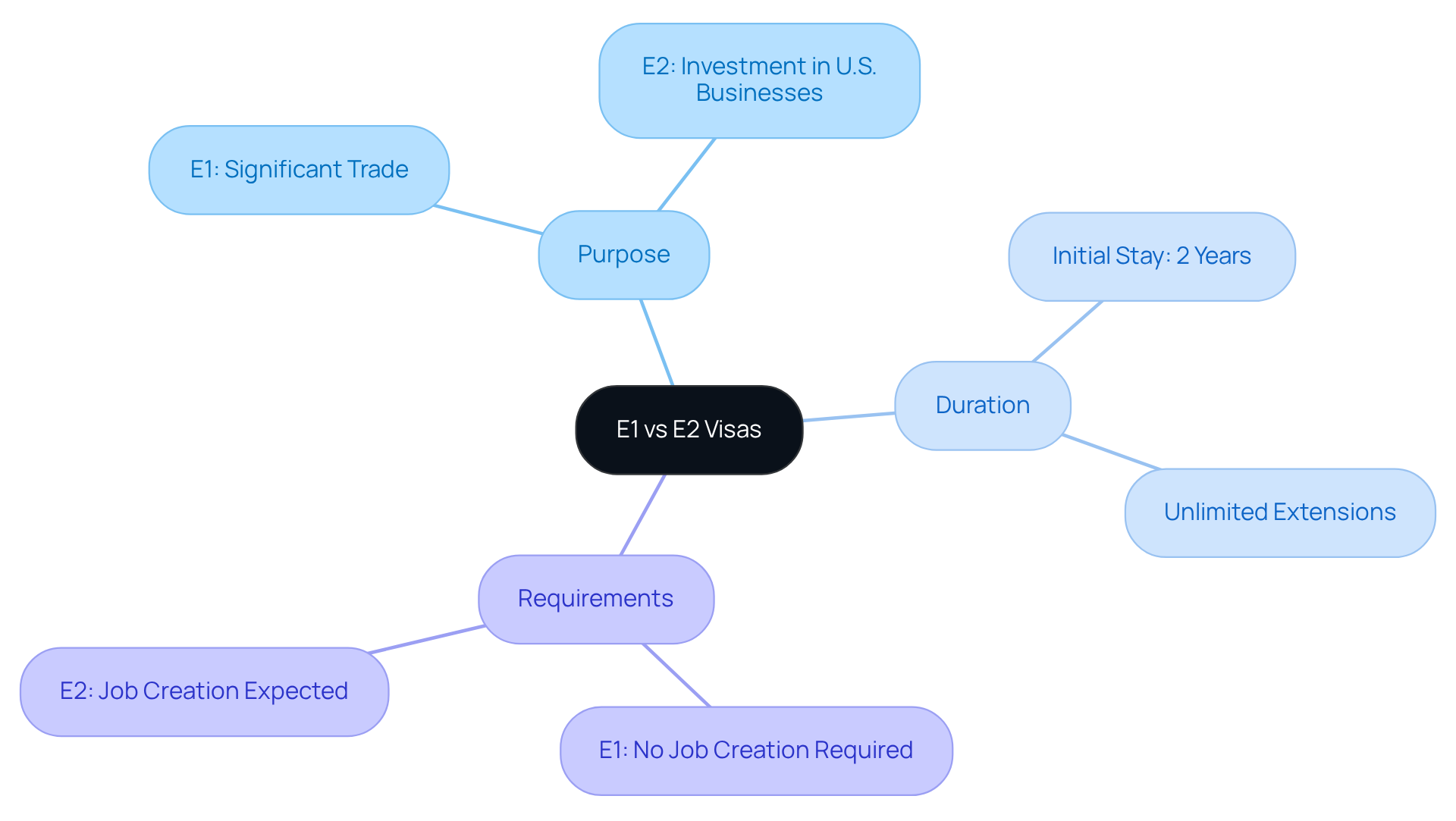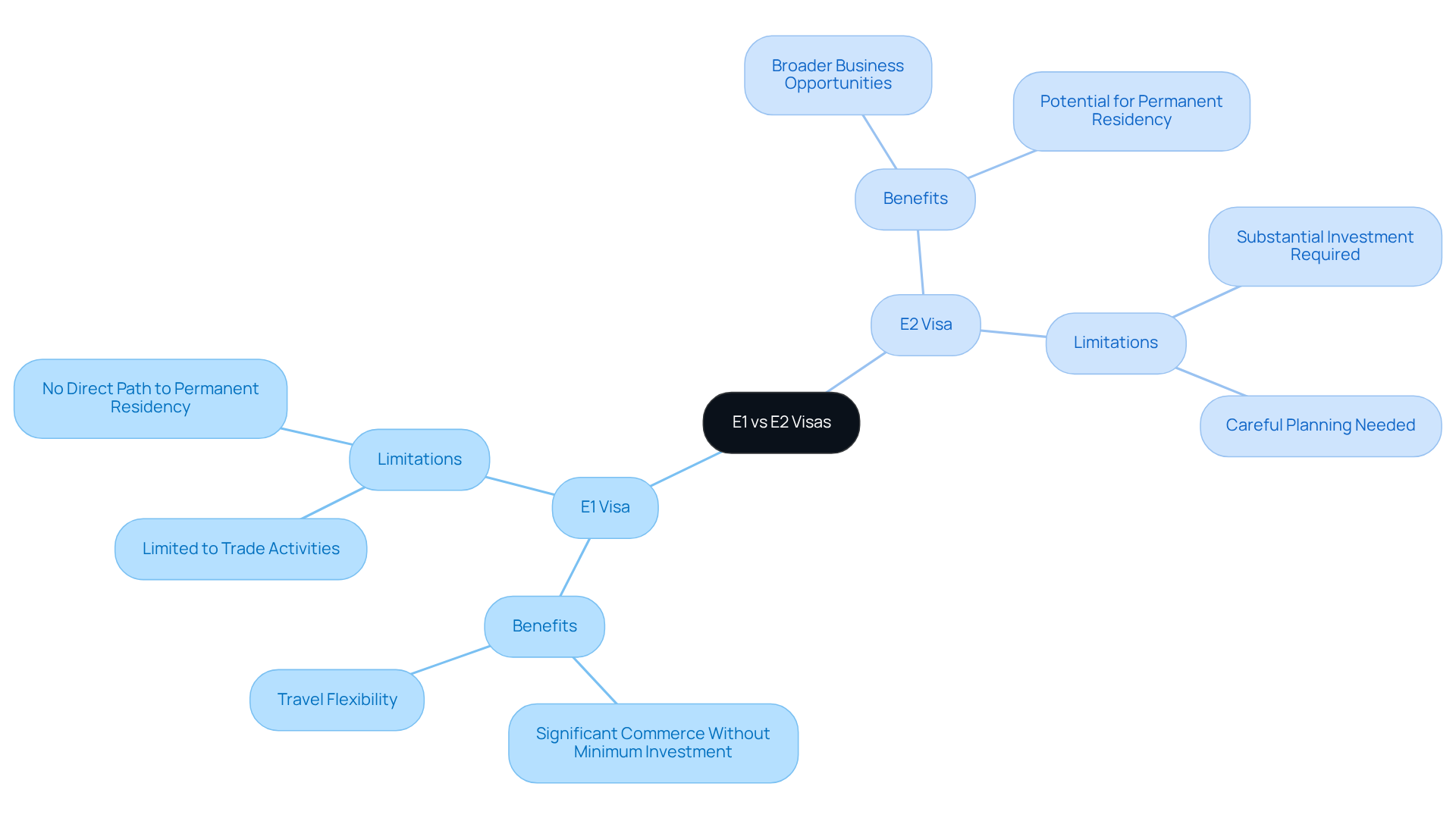Introduction
Navigating the complexities of U.S. immigration can feel overwhelming. Have you ever found yourself lost in the maze of visa options? The E1 and E2 classifications are two pathways that might be right for you, especially if you’re from a treaty country. The E1 visa focuses on significant trade, while the E2 visa emphasizes substantial investment in U.S. businesses.
As interest in these visas grows - especially with a notable increase in E2 approvals - prospective applicants face a crucial question: which visa aligns best with your goals? Understanding the key differences and benefits of each visa type can pave the way for successful immigration. Remember, you’re not alone in this fight; we’re here to guide you every step of the way.
Understanding E1 and E2 Visas: Definitions and Context
Navigating the world of immigration permits can feel overwhelming. If you’re considering the E1 vs E2 visa options, you’re not alone in this struggle. These nonimmigrant classifications are specifically designed for nationals from countries that have treaties of commerce and navigation with the United States.
The E1 permit, known as the Treaty Trader permit, allows individuals to enter the U.S. to engage in significant commerce between their home country and the U.S. This is a game-changer for those involved in international trade, as it simplifies the movement of goods and services across borders.
On the flip side, the E2 classification, or Treaty Investor permit, opens doors for individuals looking to invest a substantial amount of capital in a U.S. business. This permit is tailored for entrepreneurs and investors eager to start or manage a company in the U.S., contributing to the economy through job creation and investment.
While both permits support business activities, the differences between the E1 vs E2 visa cater to different economic engagements-trade for E1 and investment for E2. Recent updates show a significant rise in the approval of applications for the E1 vs E2 visa in 2025, reflecting a growing interest in these pathways. For example, E2 approvals saw a 15% increase compared to the previous year, highlighting a rising trend among investors.
Real-world stories of E1 vs E2 visa holders reveal the diverse opportunities that are available. Take, for instance, an E2 permit holder from Canada who launched a successful tech startup in Silicon Valley, creating jobs and boosting the local economy. As these classifications evolve, understanding their nuances is crucial for prospective applicants.
Experts like Alexander Jovy stress that with the right legal strategy, E-2 entrepreneurs can pursue permanent residency, securing long-term stability for their families and businesses. Remember, you don’t have to navigate this alone-we’re here to fight for your family and future.

Eligibility Requirements for E1 and E2 Visas
Navigating the e1 vs e2 visa processes can feel overwhelming. Have you ever felt lost in the immigration maze? To be eligible for the E1 permit, you need to be a citizen of a treaty nation and demonstrate that over 50% of your commerce is with the U.S. You’ll also need to show proof of significant business activities. However, keep in mind that when comparing the E1 vs E2 visa, E1 permit holders are limited to activities tied to their commerce.
On the other hand, if you’re considering the e1 vs e2 visa, you must also be a national of a treaty country. The key difference? You need to invest or be in the process of investing a significant amount of capital in a U.S. enterprise. Unlike the E1 category, the E2 classification doesn’t impose a strict percentage requirement for trade volume. Instead, it emphasizes the importance of your funding and the overall viability of your business. Experts often suggest an investment sum between $100,000 and $300,000 to strengthen your E2 application, as amounts under $100,000 might raise questions about your business's legitimacy.
The e1 vs e2 visa permits both allow for an initial stay of two years, with unlimited renewals, providing you with the flexibility you need. Processing times differ: E1 applications generally take two to four weeks, while E2 applications may take four to six months. The good news? The E2 permit boasts a high success rate, with about 90% to 92.5% of applications accepted in recent years. This indicates a favorable environment for well-prepared applicants.
However, it’s crucial to be aware of common pitfalls. Insufficient documentation and failure to meet eligibility criteria are frequent reasons for denial in applications for the e1 vs e2 visa. Recognizing these challenges can enhance your chances of success. Remember, you’re not alone in this fight-we’re here to support you every step of the way.

Comparative Analysis of E1 vs E2 Visas: Key Differences
Navigating the world of immigration permits can feel overwhelming. Let’s break down the key differences between the E1 vs E2 visa so you can make informed decisions.
When considering the E1 vs E2 visa:
- The E1 permit is tailored for individuals engaged in significant trade.
- The E2 permit is designed for those investing substantial funds into U.S. businesses.
Understanding this distinction is crucial for your journey.
When it comes to duration:
- The E1 permit typically offers an initial stay of two years, with the possibility of unlimited extensions.
- The E2 permit also allows for an initial two-year stay, which can be extended indefinitely as long as the business remains operational.
It’s important to note the differences in requirements between the E1 vs E2 visa:
- E1 permit holders aren’t required to create jobs.
- E2 permit holders are often expected to contribute to job creation within their enterprises.
We understand how confusing these processes can be, but you don’t have to navigate them alone. We’re here to fight for your rights and guide you every step of the way. Your future matters to us.

Benefits and Limitations of E1 and E2 Visas
When considering the e1 vs e2 visa, it's important to note that the E1 visa offers several advantages, such as the ability to engage in significant commerce without a minimum investment requirement and the freedom to travel in and out of the U.S. Many traders hold onto their E1 status for years by continuing their commercial activities. However, it’s important to note that this visa is limited to those involved in trade activities and doesn’t provide a direct path to permanent residency.
On the other hand, when considering the e1 vs e2 visa, the E2 visa allows for a broader range of business endeavors and can lead to permanent residency through funding routes. While it requires a substantial investment, there’s no set minimum amount, which can be a hurdle for some applicants. Both permits also allow the holder's spouse and children to join them, making them more appealing for families.
In fiscal year 2020, the E1 classification saw a significant number of approvals, yet it remains a temporary solution without a direct route to a green card. Notably, E-2 approvals hit an all-time high of 54,812 in FY 2023, showcasing its popularity among investors. While the E2 visa opens up greater entrepreneurial opportunities, it demands careful planning and paperwork to demonstrate that the investment is substantial and supports a viable business. For example, small consulting firms might need to invest between $80,000 and $100,000 to meet the substantiality requirement.
Recent updates show that E1 visa holders enjoy travel flexibility, allowing them to maintain their trade activities while living in the U.S. However, both visa types require ongoing compliance with operational expectations to secure extensions. It’s crucial to remember that the e1 vs e2 visa options necessitate that the applicant's home country has a treaty with the U.S. As the landscape of U.S. immigration evolves, understanding these limitations and benefits is vital for immigrant workers looking to establish their presence in the U.S.

Conclusion
Navigating the complexities of U.S. immigration can feel overwhelming, especially when it comes to the E1 and E2 visas. These visas offer distinct pathways for immigrant workers eager to engage in commerce or invest in the United States. Understanding these options is crucial for anyone looking to seize the opportunities available.
The E1 visa is all about significant trade activities, while the E2 visa focuses on substantial investments in U.S. businesses. Each caters to different entrepreneurial ambitions, and knowing the differences can make a world of difference in your journey.
As we explored these visas, key points emerged:
- Eligibility requirements
- Processing times
- The unique benefits and limitations of each type
E1 visa holders enjoy travel flexibility and can engage in trade without a minimum investment requirement. In contrast, E2 visa holders must invest a significant amount in a business, which can lead to permanent residency. The recent increase in approvals for both visas shows a growing interest and a favorable environment for those prepared with the right documentation and strategies.
Ultimately, the choice between the E1 and E2 visas depends on your individual circumstances, goals, and the nature of your business activities. Take the time to evaluate your options carefully. Seeking professional guidance can enhance your chances of success. Embracing these immigration pathways can lead to fruitful opportunities and a promising future in the U.S. Remember, understanding and leveraging the benefits of each visa type is key.
We’re here to fight for your family and support you every step of the way. Your future matters to us. Yo Peleo - We Fight.
Frequently Asked Questions
What are E1 and E2 visas?
E1 and E2 visas are nonimmigrant classifications for nationals from countries that have treaties of commerce and navigation with the United States. The E1 visa, or Treaty Trader permit, allows individuals to engage in significant commerce between their home country and the U.S., while the E2 visa, or Treaty Investor permit, is for those looking to invest a substantial amount of capital in a U.S. business.
What is the purpose of the E1 visa?
The E1 visa is designed for individuals who wish to enter the U.S. to engage in significant trade between their home country and the U.S., facilitating the movement of goods and services across borders.
What is the purpose of the E2 visa?
The E2 visa is intended for entrepreneurs and investors who want to invest a substantial amount of capital in a U.S. business, thereby contributing to the economy through job creation and investment.
How do the E1 and E2 visas differ?
The primary difference between the E1 and E2 visas lies in their focus: the E1 visa caters to trade activities, while the E2 visa is geared towards investment in a business.
What recent trends have been observed regarding E1 and E2 visa approvals?
In 2025, there was a significant rise in the approval of E1 and E2 visa applications, with E2 approvals seeing a 15% increase compared to the previous year, indicating a growing interest in these visa pathways.
Can E2 visa holders pursue permanent residency?
Yes, E2 visa holders can pursue permanent residency with the right legal strategy, which can provide long-term stability for their families and businesses.
Are there real-world examples of E1 and E2 visa holders?
Yes, there are diverse opportunities available for E1 and E2 visa holders, such as an E2 permit holder from Canada who successfully launched a tech startup in Silicon Valley, creating jobs and boosting the local economy.




